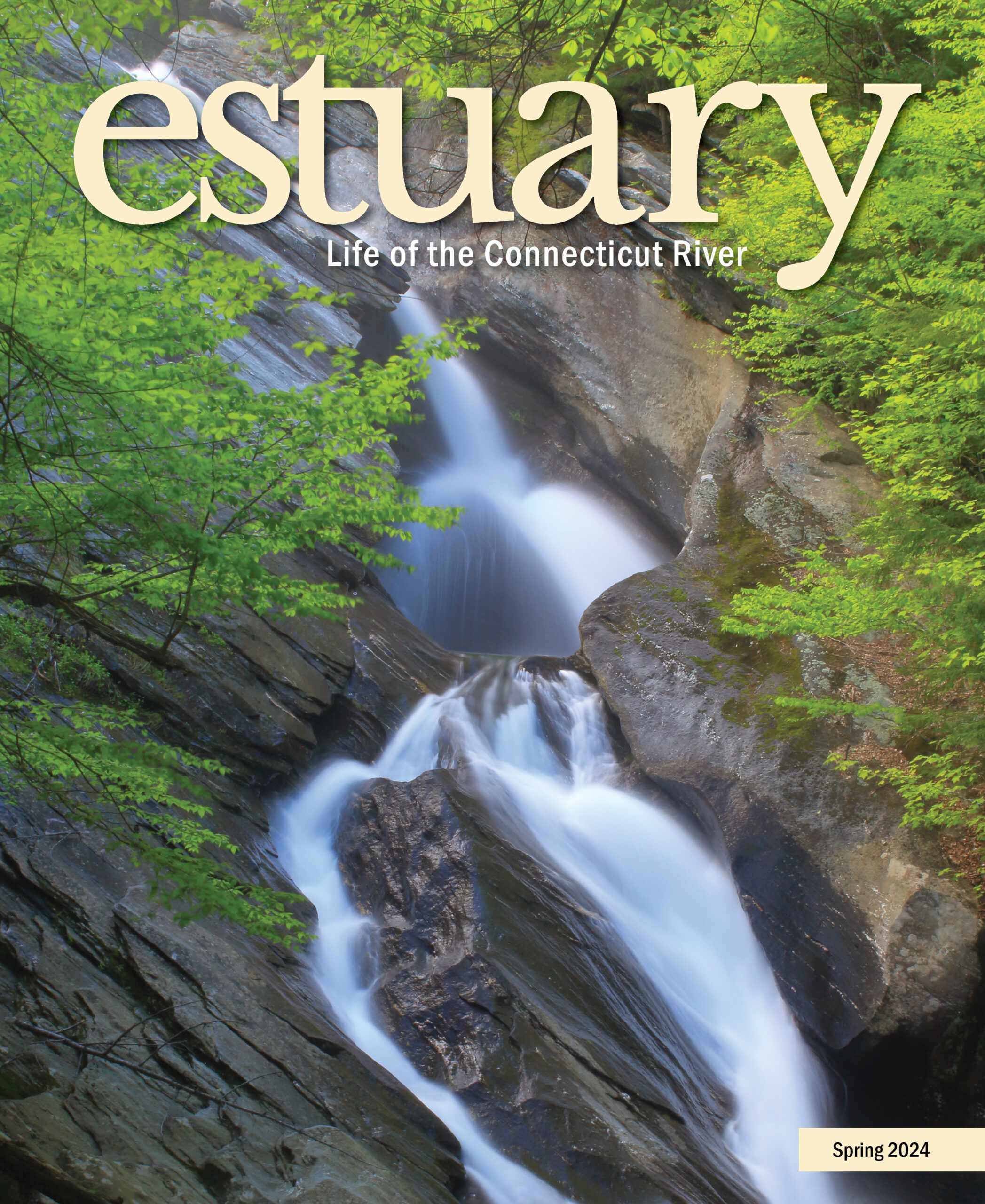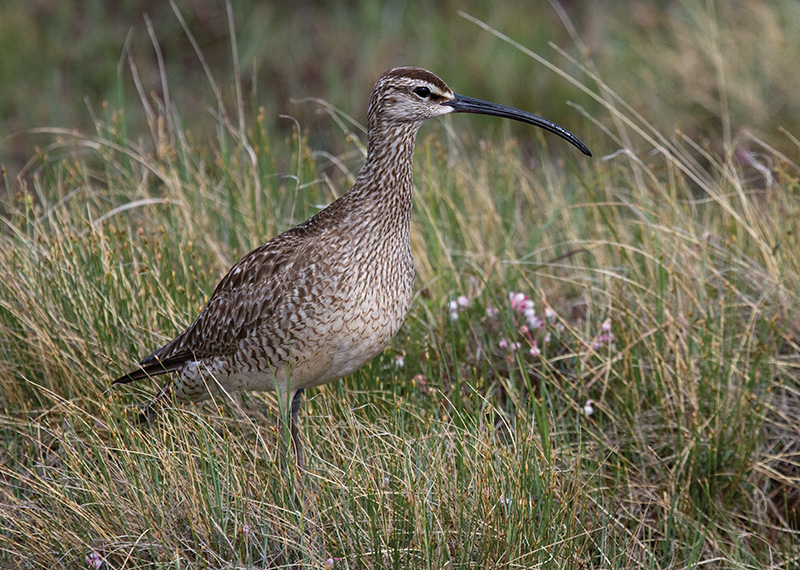 This article appears in the Spring 2024 issue
This article appears in the Spring 2024 issue

As a Massachusetts boy who had been seeking out new birds for better than a year, I was possessed by an unwritten “wish list” of some ten or fifteen species I’d tried desperately but failed to see.
I wasn’t overreaching in this list, mind you. I didn’t ask for anything outlandish like a Bachman’s warbler (probably extinct), or a black rail (impossible to see), or a prismatic purple gallinule (astray from the far south). Indeed each of these species I so wished for had been seen by someone, somewhere in New England, every year. So with some persevering effort, why not me? It didn’t seem too much to ask, yet they continued to elude me, every one; and among the few that tantalized me most were both the loggerhead shrike—a roguish-looking bird with a black mask, inclined to perch in open fields—and in a class all by itself, the tundra-nesting shorebird with the “sickle bill”: the Hudsonian curlew.

Whimbrel (Hudsonian curlew), Churchill, Manitoba, July 2011. ©William Burt.
Hudsonian curlew. The very name evoked a romance of the distant wild, though sad to say that name has since been tossed in favor of the impenetrable Old World name of whimbrel. But when would I see one—and the black-masked shrike, as well? The big days came when I was just fourteen, and visiting my grandfather in Old Lyme, Connecticut.
When making my way out through the fields for Griswold Point one August morning, eager for the beaches, I looked up to see a gray-and-white bird perched high in a pepperidge tree. A mockingbird, no doubt…but no, this bird was looking down at me askance through a black mask—a shrike!—and eyeing me from just two branches down was yet a second shrike. A few days later I was wading out through the same field, still giddy at the thought of that twin miracle, when something new snapped into view—so what was this? Not forty feet ahead stood a commanding shorebird, big as a duck, and brown, with the long sickle bill of what could only be a curlew: a Hudsonian curlew! The great bird rose up from the grass with a wild piercing cry, flew out over the water, and winged westward down the coast.
Loggerhead shrike, Hudsonian curlew: I’d seen them both, just days apart—and only yards apart, in the same summer pasture. But I had other wish birds yet to see, and none bewitched me so as the strange little ground bird with the two black “horns.”
That one wouldn’t come so easily.
![]()
According to my Peterson Field Guide, the horned lark belonged to a small coterie of open-country ground birds that included several longspurs, the snow bunting, and two pipits. But the lark alone had those black feathered “horns” on top, which lent it a peculiar aura I found irresistible. I gazed upon its picture often, and with every rightful hope that I should see it, for unlike the other ground birds in the book it was supposed to nest not only in my own home state of Massachusetts but in all New England, and beyond. Yet for all my searching I had never seen a trace of the horned lark, and I began to wonder if I ever would.
I turned back to my Peterson and trawled down through the text again, still hoping for some clue I might have missed. Where did this strange bird keep itself?
Its breeding range, I read, extended “from the arctic to North Carolina,” and across the continent from coast to coast. Within this huge hunk of the hemisphere it thrived in a variety of open country habitats, so it could hardly be too fussy. The horned lark “frequents plains, prairies, fields, golf courses, and shores,” the book assured me, and at last it dawned on me: golf courses! I’d read something else about golf courses and horned larks in a charming little book by John Kieran called An Introduction to the Birds. Its pages introduced young readers to the blue jay, catbird, killdeer, and about 100 other backyard birds for ten-year-olds, and one—included just to needle me, it seemed—was the elusive ground bird I had never seen. And yes, wrote Mr. Kieran, this “mild mannered little bird” was at home in any kind of open country, including “those well-groomed gems of greenery, the golf courses of the United States and Canada.” Then, as if he hadn’t been provocative enough, he added, “There probably is no golf course in North America that doesn’t have, in the course of a year, more horned larks than members walking the fairways.”
That did it. We had no plains or prairies in suburban Boston, but we did have eighteen fairways “well-groomed” by the Pine Brook Country Club, and they lay just beyond the old stone wall, a minute’s walk from my backyard.
One gummy, hot, late-summer morning I set out on a determined expedition and walked fairway after fairway, scanning acre after acre, well into the steamy afternoon. But it was no use. I saw no birds of any kind on any of those sunbaked fairways—not even a lone chipping sparrow. I made it to the 15th hole, I think, before returning in defeat.
Those Pine Brook fairways were a boon to boyhood baseball, bike-jumping, and field-testing a new boomerang or Roman candle, and perhaps to golf as well. But they were no place for finding birds.
Would I ever find the little ground bird with the two black “horns”? In a few weeks now I’d be shipped off to boys’ school in the hinterlands of Maine—the wooded hinterlands—so the big day might not be for years.
![]() One Friday evening in October, only six weeks into the fall term, Headmaster Allen skipped the small talk to inform us of the crisis. Tomorrow was the day of a home football game, and it would be one of the biggest of the season, he reminded us. But a freak storm had left the countryside shin-deep in snow. “So boys, what shall we do?” No sooner had he asked—rhetorically, of course—than he supplied the answer.
One Friday evening in October, only six weeks into the fall term, Headmaster Allen skipped the small talk to inform us of the crisis. Tomorrow was the day of a home football game, and it would be one of the biggest of the season, he reminded us. But a freak storm had left the countryside shin-deep in snow. “So boys, what shall we do?” No sooner had he asked—rhetorically, of course—than he supplied the answer.
“Well, I think we have an opportunity here for all you freshmen to pitch in and demonstrate your new school spirit, and help shovel off the field. How about it, boys? What do you say?”
Nobody dared a sound, but you could almost hear the groans.
“All right then. If you freshmen boys will pitch in with the members of the team and we get a good early start, I think we can do it. Game time is 2 p.m., but what do you say, boys? I’ll wager that we could have it all shoveled off clean and ready by 12 noon!”
Shoveled off clean the entire football field by hand? That’s what he had proposed, and that’s what we would do. After a grim 6:30 breakfast we all donned our winter wear, collected shovels at the gym, and set out to shovel off the football field. By hand.
After two long hours of sweaty, soggy lifting, and all in the interest of a football game—best not to think about it—I paused to wipe my brow and look around and survey our progress. We’d cleared off nearly thirty yards, and it looked good. About a third of the whole playing field was now a muddy-green oasis in a world of white. I stood leaning on my shovel, admiring this hand-fashioned miracle of earth and grass, when I caught sight of something moving—then a few things moving, far back in a corner of the field we had already cleared, and they were birds alright—small birds. I could make out about a dozen pale brownish jobs about the size of sparrows weaving about and picking at the turf. As I watched transfixed, about a dozen others swept down from the sky and settled in among the rest.
What else could they be, but sparrows? Yet these brown birds didn’t hop, as sparrows do. They walked, heads nodding as they searched for bits to pick at. I did not allow myself the wild suspicion yet, not at this distance, though these birds were something different, surely. I had to get in close.
With shovel over shoulder, I walked back along the sideline toward the birds—there was no stopping me—and I soon saw that some were slimmer and darker than the others, and these birds were streaked beneath. So there were two birds here that I had never seen before. I had to get in closer, come what may, and next I knew I was already at the far end of the open field, alone and staring bug-eyed at my first horned larks—and my first American pipits, too, of course! How often I had ogled them together in my Field Guide, and now here they were, alive and moving on real—
“Hey, YOU!”
The deep voice of a man came booming down the field, bursting the spell, and jolting me into the here-and-now of boys, and shovels, and a job to do. It was the rotund football commissar, Coach Ossman. He stood staring with a disbelieving smirk.
“We’ve already shoveled there,” he boomed again. Then sure enough, on came the rumble of boys’ laughter, and with head down I returned to duty.
![]()
Four weeks later I was back at Old Lyme for the Thanksgiving weekend, chomping at the bit to get back out to Griswold Point. No sooner had I stepped out on the beach than a pale brownish owl flopped up out of the dune grass and winged stiffly down the point like a great feathered moth, then dropped and disappeared: a short-eared owl, the first I’d ever seen.
Up on the beach ahead was a close group of half a dozen jobs that might have been plump sparrows but they had no streaks, no definition, only a pale brownish wash, which gave them an odd, smudgy look. I had no idea, but then they whirled off in a flash of white, and I knew instantly: my first snow buntings. A bit farther down the beach was still another group, again like sparrows but a little larger, and they walked along, heads nodding like so many doves as they picked through the seaweed wrack…and yes, here were my newfound friends again—horned larks—and there was not a Football Commissar in sight.
That’s how it often goes when you’ve encountered a new bird or a new person, word, or a new almost anything. You’ve come upon it for the first time ever, and you’re treasuring the moment still when presto—it pops up again.
William Burt is a naturalist, photographer, and writer with a passion for wild places—especially marshes—and the elusive birds few people see. He is the author of four books, lectures often, and his traveling exhibitions have been shown at some 35 museums across the US and Canada.
